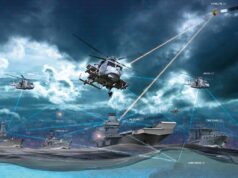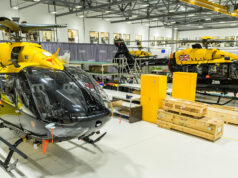AVX Aircraft Company and L3 Technologies have announced their coaxial helicopter design, which is competing for Phase 1 of the US Army Future Attack Reconnaissance Aircraft (FARA)-Competitive Prototype (CP) programme competition.
The company say that the pictured CCH design, combined with rigorous engineering and production processes and certifications, will deliver a ‘safe, performance-driven, affordable aircraft’ capable of operating in highly contested airspace and degraded environments for extended periods.
“This FARA-CP solution provides L3 and AVX an opportunity to demonstrate the agility and innovation that sets our team apart in support of the US Army’s modernisation priorities,” said Christopher E. Kubasik, Chairman, Chief Executive Officer and President of L3 Technologies in a news release.
“We are collaborating to deliver a prototype that provides powerful leap-ahead capability for our warfighters at an affordable life-cycle cost.”
“We are extremely pleased to reveal the design for this very important U.S. Army program,” said Troy Gaffey, AVX CEO and Chief Engineer.
“AVX and L3 provide unique engineering design skills and manufacturing expertise that will provide the Army with an advanced, lethal and affordable reconnaissance and light-attack platform.”
According to the company, their design offers the following features:
- A fly-by-wire, side-by-side cockpit optimized for pilot efficiency
- Two ducted fans that provide forward and reverse thrust for both high-speed operation and agility
- State-of-the-art modern open systems architecture (MOSA)-based digital backbone and avionics systems
- A small form factor that meets C-17 loading and Navy DDG shipboard size limits through manually folding blades and wings
- Modularity that provides for component reuse and a high degree of systems commonality across all of the U.S. Army capability sets














Am I correct in thinking that helicopter development has moved at a snail’s pace over the last 50 years? The Chinook concept (two separate rotors) is as old as gin. Okay, attack helicopters broke the mould; but recent developments could radically change the way they fly and carry. I do believe we are on the frontier of an exciting period in helicopter design.
Yes to a degree but, the very nature of the concept limits certain criteria such as top Speed, Ceiling, Stealth and payload.
Having said that, the current direction Is changing the basic design and addressing all of the afore mentioned, hence the Tilt Rotor designs and the Boeing Defiant.
Ever seen a Chinook do a Display ? Bloody Incredible.
Yes, is the short answer. There has been a massive leap in material technology for airframes and engines, we should also include avionics and digital flight controls. However, if we look at basic helicopter aerodynamic design, the only real advancement has been with the semi-rigid head and BERP blade tip designs.
The major problem facing all helicopters is the relative airspeed over the advancing and retreating blade tips.
I’ll try to keep this explanation rather basic and not go into retreating blade stall issues. Because the tips are much further out than the inboard portion of the blade they are going significantly faster through the air. Therefore depending on the blade profile, distance from the rotor hub and the local airspeed, generally the blade tip will be operating in or just under the transonic zone.
For helicopters this is more important than fixed wing aircraft. One of the reasons is that a helicopter requires more flex in the blade to cope with sudden loads such as lifting an underslung load etc. A flexible blade also helps to mitigate natural vibration generated by rotating a large object. As the blade tip goes faster the local airspeed will increase and at some point the airstream will start to separate from the blade thus increasing drag. As the local airspeed goes supersonic we enter areas of air compress-ability issues, which basically chops lift and significantly ramps up drag. But because a blade has a lot of flex, the supersonic airflow will try to twist it, thus placing a lot of strain on it. As the blade rotates around the hub it will be going in and out of the supersonic airflow which will induce a ripple in the blade and at some point matching the fatigue resonance causing it to break.
If you look at a Chinook blade you will see how thick the first third of the blade is compared to the tip. This is so the tip can still generate lift at high subsonic speeds. The Chinooks rotors operate within a constant speed range which is governed by the digitally controlled engines. The blades are 40 foot long and 2 foot wide rotating at 225rpm. The relatively low rpm is so that the tips stay in the low transonic zone and don’t go into the supersonic zone.
If you look at a Merlin/Lynx/Wildcat fitted with the BERP blades these operate slightly differently. The rotor speed is still governed to operate within a constant speed band. However, due to the shape of the tips, it allows the tips to still generate lift in the transonic to supersonic zone. You’ll also notice how rigid these blade are compared to say the Russian designs. The Merlin uses active damping to mitigate vibrations reaching the cabin and compared to the Chinook feels like an airliner as a passenger.
If you seen and heard a Chinook, you’ll notice it has a very distinctive noise, especially when it is operating near its top speed or performing a tight turn. This is due to the air interaction between the airframe and intermeshing blades. Basically as the blade tips start to intermesh the air is beginning to be compressed and as it passes over the fuselage rapidly expands. This generates the “wokka” noise, but also more importantly wipes out the lift between the two blades. This induced turbulence causes significant and noticeable vibration in the airframe.
If you look at the Kamov coaxial designs, you’ll notice that the rotor heads are widely spaced apart unlike the Sikorsky designs. A lot of this is down to material design, but also Kamov’s approach to blade turbulence interaction. If you imagine a biplane wing, the upper and lower wingtips generate a pair of rotating vortices, when these meet a significant amount of drag is generated. This is the same with coaxial designs. There will be a point where drag will significantly slow the aircraft down, which is why the SB-1’s propeller is so big, as its using brute force to overcome the drag. It would probably struggle to get past 300 knots
The answer to the drag problem is the compound helicopter or tilt rotor aircraft. The issue with the tilt rotor is that you are limited by the rotor disc size, which must clear the fuselage in aeroplane mode as compromise must be reached to determine the wing span. This limits the amount of vertical lift the rotors can produce thus limiting your vertical lift capacity.
The compound helicopter works by slowing down the rotor speed. The Airbus X3 does this by at least 15% or removing the drive to the rotors as per the Fairy Rotordyne. It also requires a fixed wing to help share the lift that helps offload the rotorblades. The X3 and Rotodyne also remove the requirement for a parasitic tail rotor, instead using differential propeller pitch to control the yaw. The X3 is significantly faster by at least 100kts than the Dauphin it is based on.
In my opinion the best option is still the Rotodyne method. Which removes drive completely to the rotors and turns the aircraft into a autogyro. This is because the rotors will only be going as fast as the local airspeed. The X3’s method will at some point reach a limit where the rotor tips are again entering the transonic zone because they will be going faster than the local airspeed.
The design of the autogyro’s blade profile can be then be matched for a purely subsonic lift design, rather than using a compromise design.
DaveyB, your knowledge on the subject is comprehensive, to say the least, and thanks for the technical background.
With ever reducing air frames, two key roles continue to be key, which are transport and attack, if they can combine the two in a reasonable price, this would help the british army a lot.
Is this not a little late to the game or is it in a niche or area other existing designs and prototypes don’t address. Looks interesting mind.
Not really, from what i read the US is looking for replacement for the blackhawk/apache. Something that can bring the troops to the battlefield and then provide close air support once there.
Sounds a lot like a Mil Mi-24/35 Hind type of aircraft… except as a hybrid fixed/rotary wing version.
So what might a UK hypothetical army orientated aircraft fleet look like in 10-15 years time, starting from where we are today? My hypothesis is that the MoD may be sitting on the sidelines looking at what the US produces from its Future Vertical Lift program, given the significant capability enhancements planned for that program, then deciding if what is developed works, is affordable and if it fits the UK’s requirements.
It seems both Apache and Chinook for the UK will be around into the 2040’s at least, based on relatively recent upgrades and orders and the longevity of these platforms in use, so nothing is likely to change for those roles IMV before then. That leaves Wildcat, Gazelle and a “gap” where Merlin HC3/3A used to be, unless Chinook is supposed to fill this role. The Gazelle’s are supposed to go OSD in 2025.
The Scout part of FVL is targeted for 2030 introduction and might replace both Wildcat and Gazelle, with a capability gap on the latter assuming no life extensions. The Wildcats might then transfer to the RN, in a similar fashion to the RAF Merlin transfer. The extra Wildcats might then be used in either the current RN role or as dipping sonar platforms to augment additional T31 frigates or a Venari 85 type vessel if dedicated MCMV replacement is chosen.
Meanwhile back on land, the Army might get the FVL Medium Utility/Attack solution as the Merlin replacement with an introduction date in the late 2020’s of V-280/SB-1 class aircraft. There is a potential issue that the range and speed of FVL Scouts and Utility solutions will significantly outstrip Apache, so both might need to be armed in order to leverage their higher performance.
The USMC want to supersize the capabilities in terms of speed and range that the US Army are after for FVL, so if the USMC gets its way then those solutions might follow at a later date for RN carrier use.
Just throwing some ideas out for folks to chew over.
My prediction is the US Army disagree with USMC and USN resulting in both mediums being procured. SB-1 for the Army and V-280 for the USMC and Navy. The Army wants reliability, simplicity and ease of entry to service while the USMC wants speed and range so they can keep their amphibs further out.
I do like the Russian coaxial style rotors, works extremely well on the KA-50 & KA-52